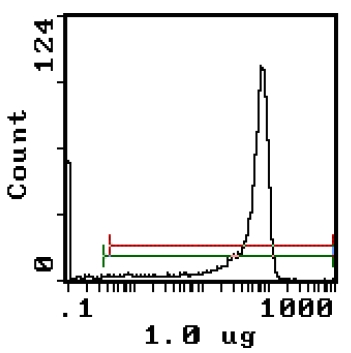Cd8b Mouse Monoclonal Antibody [Clone ID: 3.4.1]
Other products for "Cd8b"
Specifications
| Product Data | |
| Clone Name | 3.4.1 |
| Applications | FC |
| Recommended Dilution | Flow Cytometry, Immunoprecipitation and Western blotting. Test Results: Tissue Distribution by Flow Cytometry Analysis: Rat Strain: Wistar. Cell Concentration: 1x10e6 cells per tests. Antibody Concentration Used: 1.0 μg/10e6 cells. Isotypic Control: PE Mouse IgG1, k. Cell Source : Percentage of cells stained above control: Thymus : 92.2% Spleen Cells : 14.6% Lymph Nodes : 40.3% |
| Reactivities | Rat |
| Host | Mouse |
| Isotype | IgG1 |
| Clonality | Monoclonal |
| Immunogen | Rat/mouse T cell hybrids expressing CD8. |
| Specificity | This monoclonal antibody reacts with the beta chain of the CD8 differentiation antigen. The 3.4.1 antibody also blocks both activation in an allogenic response and cell mediated cytotoxicity by CD8 T cells. |
| Formulation | PBS containing 0.02% Sodium Azide as preservative and EIA grade BSA as a stabilizing protein to bring total protein concentration to 4-5 mg/ml. Label: PE State: Liquid purified IgG fraction. |
| Concentration | 0.1 mg/ml |
| Purification | Protein G Chromatography of Ascites fluid. |
| Conjugation | PE |
| Gene Name | Rattus norvegicus CD8b molecule (Cd8b) |
| Database Link | |
| Background | CD8b is expressed on most thymocytes and mature T cytotoxic/suppressor cells (MHC class I restricted). While the CD8a and CD8b form a heterodimer on the surface of thymocytes and thymus-dependent T cytotoxic/suppressor cells, the majority of NK cells, many CD8 T cells from athymic rats, many activated CD4 T cells, and intestinal epithelium lymphocytes (IEL) express CD8a without CD8b. This suggests that expression of the CD8 heterodimer (a/b) is more dependant on intrathymic T cell maturation than that of the homodimer (a/a). The thymus dependence of CD8a/b T cells may be due to a requirement for thymic selection on self MHC class I antigens. |
| Synonyms | CD8B, CD8B1 |
| Note | Protocol: Flow Cytometry Analaysis: Method: 1. Prepare a cell suspension in media A. For cell peparations, deplete the red blood cell population with Lympholyte®-Rat cell separation medium. 2. Wash 2 times. 3. Resuspend the cells to a concentration of 2x10e7 cells/ml in media A. Add 50 μl of this suspension to each tube (each tube will then contain 1x10e6 cells, representing 1 test). 4. To each tube, add 1.0 µg* dilution of SM260RX per 10e6 cells. 5. Vortex the tubes to ensure thorough mixing of antibody and cells. 6. Incubate the tubes at 4°C for 30 minutes. (It is recommended that the tubes are protected from light since most fluorochromes are light sensitive). 7. Wash 2 times at 4°C. 8. Resuspend the cell pellet in 50 μl ice cold media B. 9. Transfer to suitable tubes for flow cytometric analysis containing 15 μl of propidium iodide at 0.5 mg/ml in PBS. This stains dead cells by intercalating in DNA. Media: A. Phosphate buffered saline (pH 7.2) + 5% normal serum of host species + sodium azide (100 μl of 2M sodium azide in 100 mls). B. Phosphate buffered saline (pH 7.2) + 0.5% Bovine serum albumin + sodium azide (100 μl of 2M sodium azide in 100 mls). |
| Reference Data | |
Documents
| Product Manuals |
| FAQs |
| SDS |
{0} Product Review(s)
0 Product Review(s)
Submit review
Be the first one to submit a review
Product Citations
*Delivery time may vary from web posted schedule. Occasional delays may occur due to unforeseen
complexities in the preparation of your product. International customers may expect an additional 1-2 weeks
in shipping.






























































































































































































































































 Germany
Germany
 Japan
Japan
 United Kingdom
United Kingdom
 China
China



